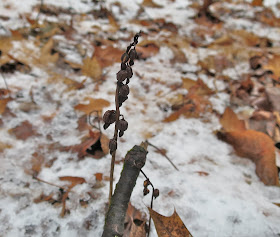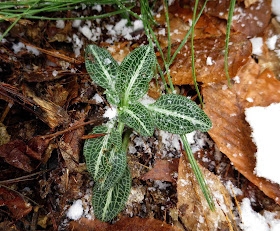Evergreens in the snow. What could be more seasonably appropriate? They're so Christmassy, after all. Evergreens of all kinds have long been considered symbols of hope in the dead of winter, and so I am looking forward to leading a nature walk featuring evergreen plants at Moreau Lake State Park this coming Friday, on behalf of the land-conservation organization Saratoga PLAN (Preserving Land And Nature). I volunteered to do this as a way to help PLAN engage local communities in conserving a region of Saratoga County they are calling the Palmertown Conservation Area. This is a large area between Moreau Lake State Park and Saratoga Spa State Park that PLAN believes has a high potential for conservation of working forests, stream headwaters, wildlife habitat, and outdoor recreation, based on the results of a recent landscape analysis carried out by PLAN to determine best use for various regions of Saratoga County.
I couldn't be happier that PLAN has asked me to participate in this conservation effort. After all, the main focus of my blog since its inception on January 1, 2009, has been to promote awareness of the amazing natural diversity to be found in exactly this area now referred to as the Palmertown Conservation Area. This area includes the Palmertown mountain range along the Hudson River, all of the Saratoga County portions of Moreau Lake State Park, other state-owned forests that are managed for timber, and also lands owned by Skidmore College in Saratoga Springs. Sounds like an index to most of the entries I've posted on Saratoga Woods and Waterways since it first went up on the internet nearly eight years ago. This is my home territory!
So yes, I'm eager to show folks the wonderful variety of evergreen plants that can be found around Mud Pond this coming Friday. I led
a similar walk for the Environmental Clearing House of Schenectady a few weeks ago, and we located more than 50 different species of evergreen plants of a marvelous variety, including trees, shrubs, mosses, lichens, liverworts, ferns, wildflowers, and even two native orchids. There's just one problem, though. On Monday, it snowed. Snow now covers the ground, and many of the plants that we found before are now hidden beneath several inches of the white stuff. I went back to Mud Pond today to see what I could find.
The beautiful low-growing mosses -- like this Common Haircap -- are still there and still green, but we aren't going to see them unless we brush the snow away.
The same goes for the colorful red-capped Cladonia lichens, hiding now beneath a mantle of white.
At least some of the club mosses, such as this Tree Clubmoss, are erect enough to protrude well above the snow cover.
But some others, like this Running Pine Clubmoss, only peek an inch or so above the snow.
Most of the ground-covering mosses and lichens will be difficult to find, but where they grow up the trunks of trees, we will be able to admire their beautiful colors and textures.
Some of our daintiest wildflowers are surprisingly sturdy, with glossy green leaves that persist throughout the winter, enduring sub-zero temperatures and heaps of snow. This Pipsissewa plant still bears the seed pods from the flowers that bloomed in July.
Striped Wintergreen also bears pretty flowers in summer, and its leaves stay fresh and green all winter long.
The bright-red fruits of Wintergreen will be just as plump and pleasant to taste next spring, after spending the winter under the snow.
I could not find the low-to-the-ground leaves of Checkered Rattlesnake Plantain, despite brushing many yards of snow away from the area where I KNEW this little orchid is known to grow. But those pale, flattened leaves are hard to find even when there is no snow. I did find the more robust and curvaceous leaves of its cousin orchid, called Downy Rattlesnake Plantain, after scuffing through the fallen birch leaves and pine needles that covered them.
At first glance, the steep banks on the south end of Mud Pond do not look as if they would yield many evergreen finds on this dark cloudy day. But sometimes looks can be deceiving. Let's look a little closer.
Sure enough, these banks were rife with all three of our evergreen ferns: Christmas Fern, Intermediate Wood Fern, and this one, called Marginal Wood Fern.
An amazing abundance of Trailing Arbutus burgeons here on these banks, with leathery leaves that will persist throughout the winter. The plants have even already produced the flower buds that will be among the first flowers to open in spring, shedding their exquisite fragrance on the still-chilly air as early as April.
I could not find the pretty leaves and fruits of Partridgeberry along the trail through the woods, but here on the steep bank where the snow is less deep, a few little plants peeped out.
I also found some of the mosses here, such as this lime-green clump of
Dicranum, that were deeply buried under snow along other parts of our trail.
UPDATE: On second viewing, I believe this moss is Bartramia pomiformis (Apple Moss), not a species of Dicranum.
I had to brush the snow off a fallen log to find this vigorous clump of Tree Moss.
Masses of the usually-floating-but-shore-stranded liverwort called
Ricciocarpa natans were also buried beneath the snow, but I knew exactly where to look for them, and my search was promptly rewarded.
This fallen log was covered with green algae, and that green algae was peppered with the tiny threads of Green Algae Fungus.
Although they're not usually green, surprising number of fungus species can be found flourishing throughout the winter, including the orange caps of
Stereum, which often thickly cover fallen logs and limbs on the forest floor.
And here was a flower, which, while not green, was certainly persistent despite the freezing weather. On most other Witch Hazel shrubs that I found in the woods today, the ribbon-like yellow petals had already fallen. But here on this shrub, they were still blooming away.
The male catkins emerging now on Hazelnut shrubs are not green, but they certainly symbolize hope for spring in the dead of winter. Thickly dangling in masses now, the catkins already hold the pollen that will later ripen to fertilize the tiny red female flowers when they open in early April.
Sweet Fern, too, has already produced the male catkins that will waft their pollen on the April air. And even though the curling leaves of this shrub (it's not really a fern) are brittle and dry, they still possess the sweet fragrance that persists throughout the winter.
Since we won't be spending a lot of time searching for mosses and lichens beneath the snow, perhaps we'll have time to notice some of the seedpods of flowers silhouetted against the white. These are the lace-like desiccated pods of the little lobelia called Indian Tobacco.
And these dainty tissue-thin cups are what remains of the little mint called Blue Curls, after the seeds have spilled to the surrounding sand.
If we are still up for further amazement, we can ponder the ice that now covers the shallow water of Mud Pond.
Have you ever wondered what causes these spidery fissures that form on lake ice? I sure have! My friend Ed Miller, an engineer who is constantly trying to figure out the reasons for things, has told me that these "spiders" are formed when the weight of the ice presses down on the water, and water springs up through weak spots in the ice. Somehow, that reason doesn't quite satisfy me, but I don't know any other explanation. At any rate, Nature is full of such wonders to ponder, and I'm awfully glad that organizations like Saratoga PLAN are working to protect such places of natural wonders as the Palmertown Conservation Area.

My evergreen-plants walk is scheduled for this coming Friday, December 9, from 1 until 3 pm. Participation is limited to 10 people. I haven't heard if that quota has been reached as yet, but those who might be interested in attending would need to email Abbie@saratogaplan.org or call her at 587-5554 to receive directions to the site and to provide contact information. Terrible weather will cancel.

































































